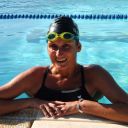By no means do I think it is easy for any parent or adult to just jump into a pool and start swimming laps. Whenever an adult student shows up for a swim lesson with me at the pool, I always feel extremely proud of them. And that’s just for showing up. Because I understand a lot stands in their way to get to the lesson. I’m going to take apart or break the myths behind the top six great excuses for holding yourself back from learning how to lap swim.
Great Excuse #1: Cannot find someone to watch my kids. Swim lessons sound like a time luxury for yourself. However, exercise is needed to keep the heart and body weight healthy so you can nurture that infant and keep up with your pre-schooler. Once you treat exercise as important as sleep, your schedule wraps itself around it. Everyone learns to adapt, just like one-car families.
Great Excuse #2: I don’t know what I’m doing. Which is why you signed up for lessons. Adults are so much more judgmental on themselves than kids ever are with swim lessons. Use what you have. Do what you can. Start where you are. Perfection is the enemy of the good.
Great Excuse #3: I’m out of shape. Swimming is one of those activities with an equal playing field for both the athletic and out-of-shape. Trust me: the challenge is going to be just as hard for a know-it-all sport freak and a vulnerable parent. In fact, the more humble you are, the better your lesson will go.
Great Excuse #4: I don’t want to be seen in a bathing suit. Remember this is a pool, not a busy shopping center. The uniform around you is suits and everyone is pretty much numb to this fact, along with different body shapes. The swimmers around you are there to get a work out, not to judge. Fake it until you make it.
Great Excuse #5: I might panic. If you take things slow, you can control your fears. You begin learning lap swimming one lap at a time. It takes the ability to apply patience, persistence and practice. These are just words and values we say, but swimming helps you get re-acquainted with their definition. It’s kind of exciting to feel these emotions (and they replace your fears).
Great Excuse #6: I don’t know where to do this. Yes, it does require looking into a pool. So start calling around and visit your local YMCA and community pools. Make sure you check out their hours for lessons as well as adult lap swimming time. Pools can be busy places that have to do balancing acts. If membership cost is an issue, look for trade-offs like free childcare, free showers and shampoo, and guest passes.
They don’t really sound like great excuses anymore, do they? Hey, I have great excuses when it comes to getting my butt into a yoga class. More on the art of exercise motivation later.








